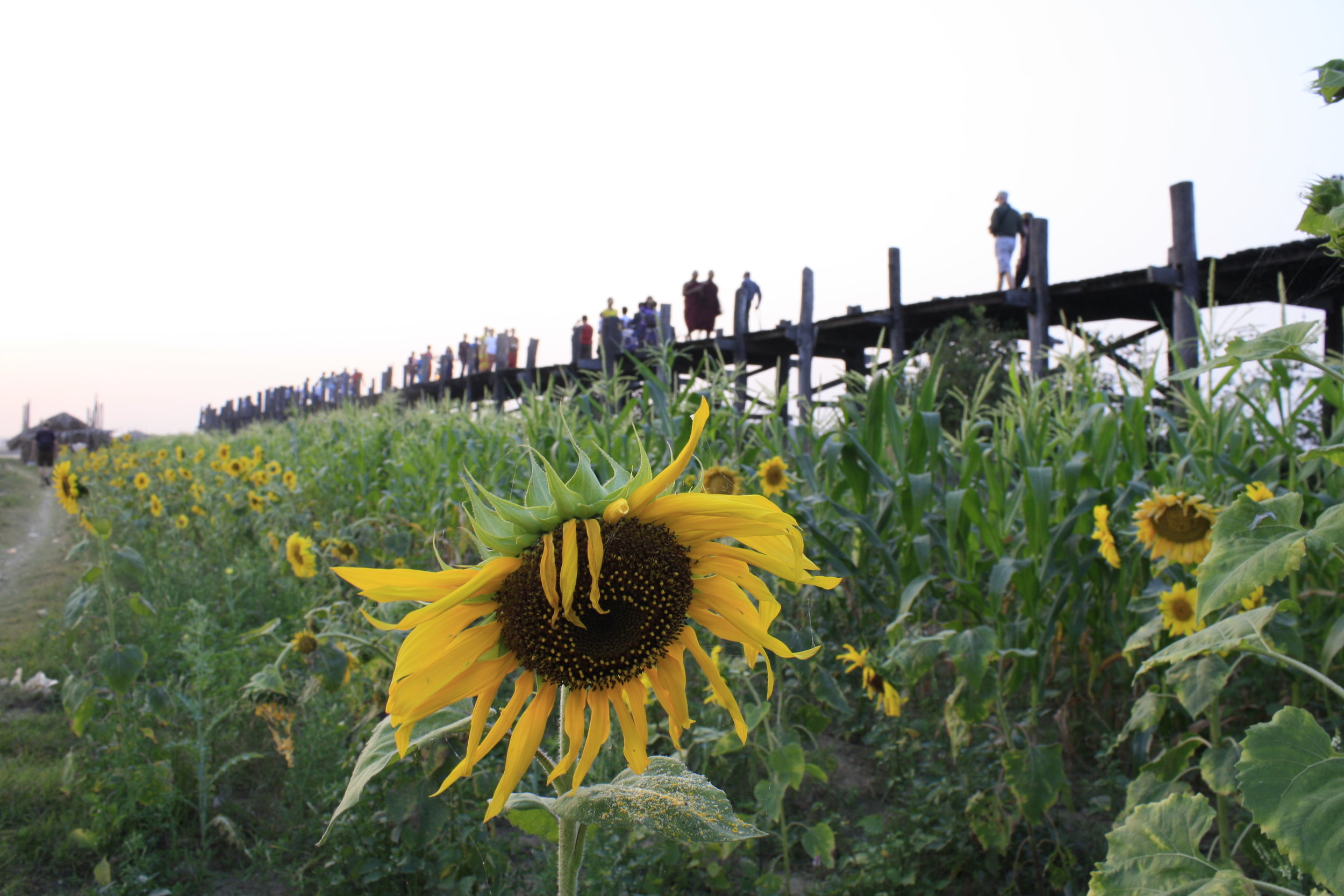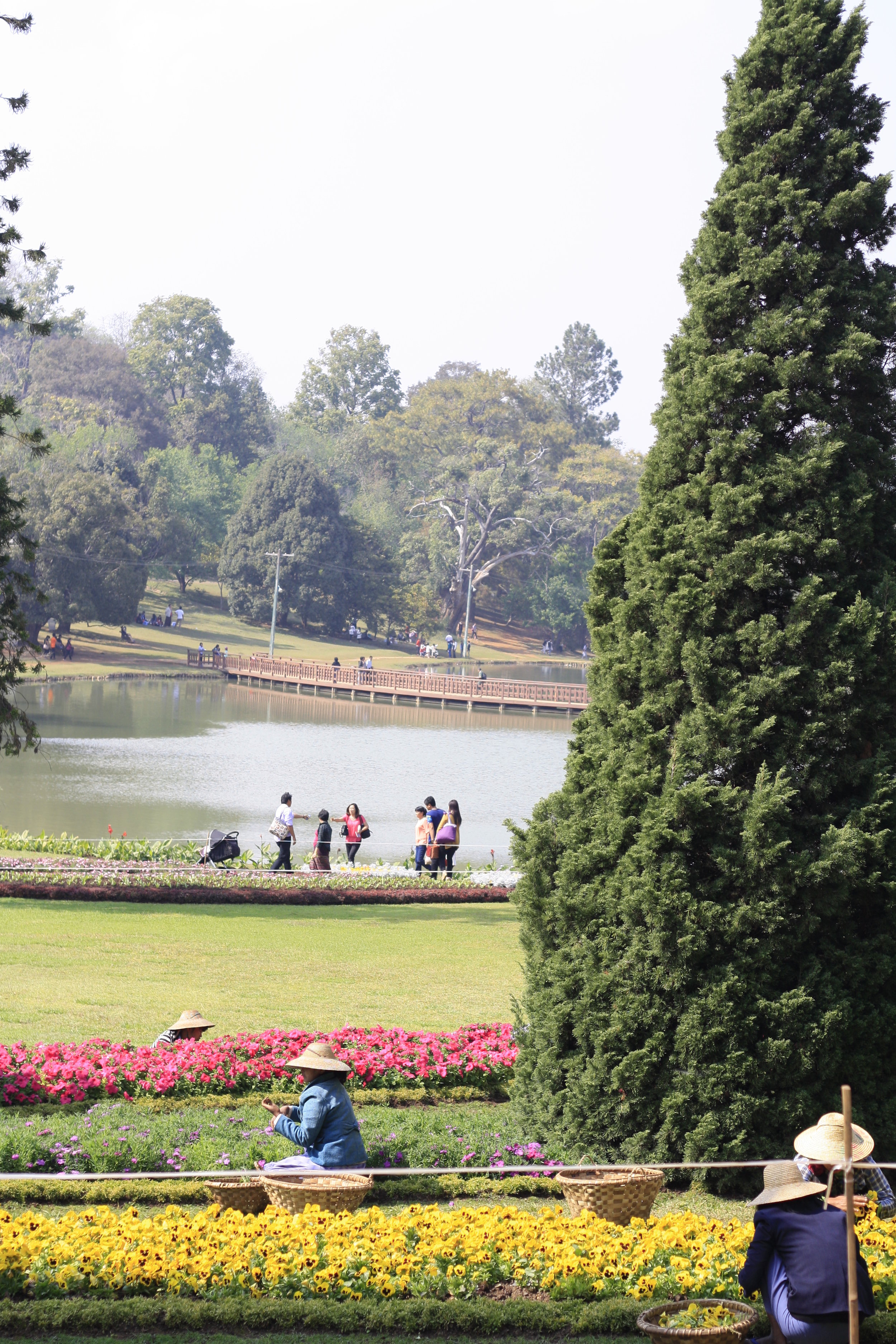Travel in Myanmar: Around Mandalay
Having really no real plans for Mandalay, we spent much of our time in a glorious state of wandering. One day we rented a motorbike and drove to the U Bein Bridge to observe the famous spot at sunset. At 1.2 kilometers long, built in the early 1850s of reclaimed teak wood from the former royal palace, this bridge is famed for being the longest of it's kind in the world. Though this proved to be an ideal spot for photos, it was disappointedly covered in tourists and souvenir vendors.
Pyin Oo Lwin After a day of bicycling around the hot and dusty city center, we were ready for a break. We decided to head for Pyin O Lwin, a scenic hill town, about 40 miles east–and at over 3500 ft, many degrees cooler. Throughout the years, this small town has served as a military post, then as a hill station and summer capital for British occupants, and finally, today, as a popular local tourist destination.
After arriving, we check into a friendly though basic guesthouse, and spend the next couple days more or less overcoming sickness and going to bed early. We manage to visit a scenic restaurant overlooking a waterfall, and make a half day of the famous National Botanical Gardens.
Though a pleasant enough experience, we both decide later on that we probably would have rather spent the time at another destination such as Inle Lake.
Back to Mandalay We head back to the city for one more day before our scheduled flight to Chiang Mai. Jim stays in to get some work done, while I set out with hopes of finding some good souvenir shopping. I take a taxi to a handicrafts factory, recommended by our hotel staff. Though this factory is filled with cheap treasures, I’m only able to find few trinkets suitable to carry with me for the next 2+ weeks of travel.
Map in hand, I decide to take the 4 or so kilometer walk back to our hotel from the factory. On my way, I take great joy in wandering through charming residential neighborhoods, crowded markets and industrial streets. I see street vendors, rickety teak houses, and several pagodas. I pass monks sweeping the streets, horse and buggies, overflowing public buses, and youths playing barefooted games of chinlon in dusty, dirt yards.
I purchase a tasty street treat which I will later regret (more on that below). I stop to see another large pagoda, and end up finding scores of souvenir vendors and plenty of small gifts to bring back with me. Even though I get temporarily lost and end up walking several kilometers more than planned, It’s an immensely enjoyable stroll.
That night Jim and I have plans to see a live show by the infamous Moustache Brothers. But first we attempt to find dinner. Around this time, in what seems all too commonly part of any Burma story, I'm seized by a sudden horrid feeling of intense nausea. In a country where I watched a cook mix a salad using her bare hands then quickly rinse those hands with tap water before collecting money or serving drinks, this doesn't exactly surprise me.
It happens at quite possibly the worst time–in the middle of dinner at a packed local restaurant. Jim and I order food (one dish, which Jim later lets me know was the best meal he had in all of Myanmar), though I'm unable to eat more than a bit of rice before I begin feeling hot, dizzy and light-headed. Finally, as our waiter and nearby diners look on, I retch into the (lucky for me) waste basket under the table.
Feeling a bit better, we head to a famous Mustache Brothers Show. The venue for this performance is the garage of the residence in which the Burmese sibling comedians are under house arrest for lampooning their government. Taped to the walls are photos of the famous brothers, performing and posing with celebrities like Aung San Suu Kyi. Much like the group's Tripadvisor reviews suggest, it's the historical significance that outshines the talent, which mostly consists of heavily accented jokes and truly bizarre dancing performed by their relatives. There's weight in the fact that many of their jokes were and are aimed at the military and the government, in a country frequently criticized for human rights violations.
Near the end of the show I'm once again overcome with nausea and must run outside to retch, this time much more violently, into the gutter. A sweet Burmese girl of about my age immediately rushes to my aid, bringing me potable water and tissues. When I'm stable, I sit with her and her family on benches in front of the theatre. Too weak to return and in fear that the loud music may bring more sickness, I sit and chat with her. She tells me she's one of the famous brothers’ daughters.
She says her father and uncles' have been performing this every night for as long as they could, taking no weekends or holidays. This is their life and likely will be for as long as the brother’s live. She says she and her husband make their living as drivers--she cannot tell jokes nor dance. Sitting and chatting with her is an enlightening experience. Unfortunately the rest of my night is not nearly as whimsical; and it's even less comfortable.
I wake the next morning, stable, though weak and exhausted. The next few hours are a blur as we head to the airport and fly to Thailand.
My overall impressions The Internet was terrible and so was most of the food. The standards for accommodations, tours and dining were a few levels below anywhere else I've ever been. But that was all ok. At one point I thought I would parish due to dehydration because I could not keep anything down, including water. But I was ok. And none of these things managed to stain my overall impression of the country.
In fact, if anything they added to the adventure. Lucky for me, I tend to look back on all my travel experiences wearing rose-colored glasses–my worst moments blurred and my best in HD quality. This experience was no exception. I have nothing but bight, sunshiny memories of impressive temples, relaxing river cruises, fresh air, tropical flowers, endlessly fascinating cities, sensory-rich experiences and delightful local people.
See Also: Myanmar Part I: Yangon to Bagan


















